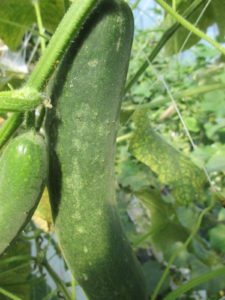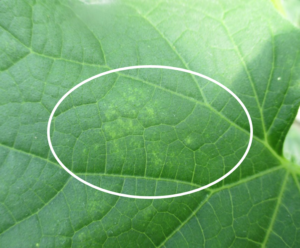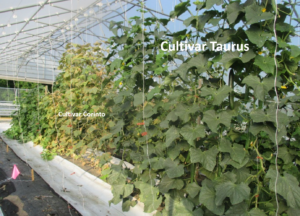Supported by NC SARE (LNC17-390), we are continuing research for improving high tunnel cucumber production.
One of the biggest challenges for growing cucumbers in high tunnels in the summer is two-spotted spider mites. Dry and hot environments featured in high tunnels allow two-spotted spider mite populations to increase rapidly. The mites cause leaf yellowing, necrosis, and defoliation that interfere with plant photosynthesis. Yield can be significantly reduced. The pest also causes direct damage on cucumber fruit, resulting in a sandpaper-like texture to the rind (Figure 1).
Early detection is the key for controlling two-spotted spider mites. As soon as two-spotted spider mites are detected, control efforts need to be taken. In the early stage, yellowish specks on the upper side of the leaves may be noticed (Figure 2). Turn the leaf over, on the other side of where the yellow specks are, you may find the presence of two-spotted spider mites. A 10× hand lens may be needed to see the pests. Infestations are highest on older leaves and at the base of the leaf near the petiole. In severe cases, two-spotted spider mites cause webbing appearance on the leaves and lead to leaf defoliation. In hot, dry conditions, mite populations can increase up to 70 times in a week.
Almost all the high tunnel cucumber cultivars are susceptible to two-spotted spider mite damage. Nevertheless, we noticed that Japanese cucumber cultivars such as Taurus seem to be more tolerant of two-spotted spider mite damage.
Several miticides are labeled for controlling two-spotted spider mites, however, they are not always allowed for greenhouse and high tunnel use on cucumbers. Frequent harvest interval of cucumbers also limits the use of some synthetic miticides. Miticides that can be used on high tunnel cucumbers and have relatively shorter preharvest intervals include Acramite®, Shuttle® O, Kanemite® etc.
Insecticide soap such as M-Pede® is commonly used to manage two-spotted spider mites in organic production. It has no residual control, so good coverage and frequent application are important to suppress pest populations. Automated water mixing systems that wet plant leaves frequently may be used to suppress the pest population.
Biological control with predatory mites is successfully used in greenhouse cucumber production. Multiple species of predatory mites are commercially available, and their efficiency may differ according to pest populations, temperature, humidity conditions, and cultural practices. Multiple releases may be required for effective control. For high tunnel production, currently, there is little information on the efficacy and economic feasibility of using predatory mites to control two-spotted spider mites.


